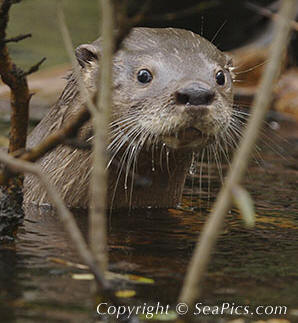Adaptations
The
Lontra provocax is one of four otter species native to the
American continents and one of the seven otter species that
exist throughout the world. As a member of the subfamily
Lutrinae the southern river otter is adapted to both terrestrial
and aquatic environments (Schröpfer and Parzefall. 2007). L.
provocax shows little preference to either marine or fresh
water environments (Schröpfer and Parzefall. 2007).

Otters are well
adapted to aquatic life; they have long streamlined bodies and
muscular flattened tails that they use like rudders when swimming
through the water (Melquist and Hornocker. 1983). Their short powerful legs are
adapted to propel them quickly through the water, their back feet
are fully webbed which helps them to paddle and their front feet are
partially webbed which allows them to forage more easily (Melquist
and Hornocker.
1983). Along with the adaptations for mobility in water all otters
have a special kind of fur that is specialized for aquatic living
and diving. They have a soft layer of underfur that traps air and
provides insulation and keeps the animal warm while diving
underwater. The underlayer is protected by glossy and stiff guard
hairs that create a nearly waterproof shield. These layers of fur
are very useful and effective but require frequent grooming in order
to maintain its waterproof qualities (Melquist and Hornocker. 1983).
Lontra provocax is a carnivorous mammal that is
considered a top predator in its environment (Vianna et.al. 2011).
Like all carnivore, Lontra provocax have longer sharp
carnissal teeth on both the upper and lower sets of teeth. These
sharp teeth are used for crushing objects and tearing flesh, while
their molars have large hard surface ideal for crushing mollusk
shells which are the otter’s main source of food (Schröpfer and Parzefall. 2007).

Lontra provocax skull: note large canine teeth.
http://thenaturalworld1.blogspot.com/2013_05_01_archive.html
References:
J.A Vianna, G. Medina-Vogel, C. Chehébar, W. Sielfeld, C. Olavarría, S. Faugeron. 2011. Phylogeography of the Patagonian otter Lontra provocax: adaptive divergence to marine habitat or signature of southern glacial refugia? BMC Evolutionary Biology, 11:53. Accepted 28 February 2011.
Schröpfer R. and J. Parzefall. 2007. Ecology and behaviour of the Southern River Otter Lontra provocax. PhD dissertation. University of Osnabrück, Osnabrück, Germany. 255 pp.
